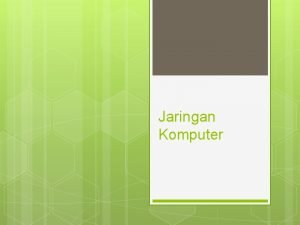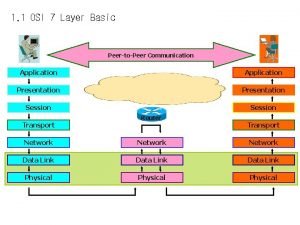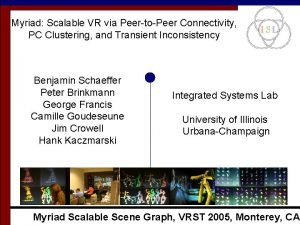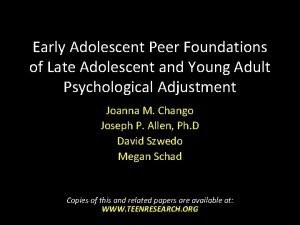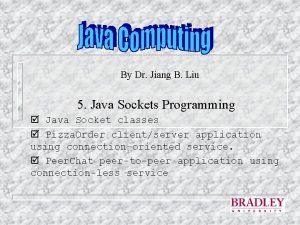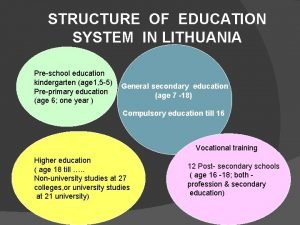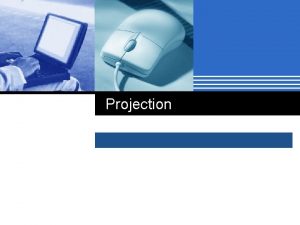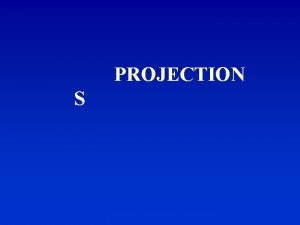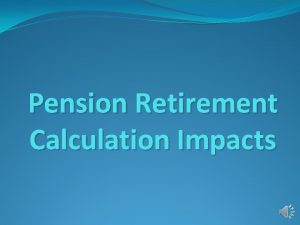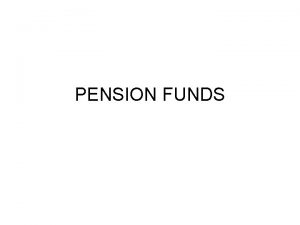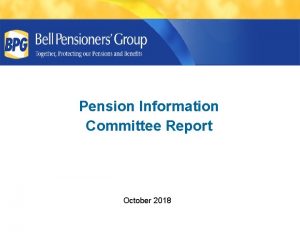Lithuanian Pension system Projection results AR 2018 Peer

































- Slides: 33

Lithuanian Pension system Projection results AR 2018 Peer reviews of pension projections Brussels, 28 November 2017 Ministry of Social Security and Labor of the Republic of Lithuania Vidija Pastukiene

Content • Key features of the pension system • Recent reforms • Results

Lithuanian pension system statutory mandatory PAYG (defined-benefit, point system since 2018) pension scheme statutory quasi-mandatory private funded (defined contributions) pension scheme voluntary private funded pension scheme

Social insurance PAYG pension scheme (1) • universal, covers all employed workers regardless of the type of their employer – is it private or state • old age, disability, widows’/widowers’ and orphans’ pensions • legal retirement age for men is 63, 5 years and for women 62 years • from 2012 it is increasing annually by 4 months for women and by 2 months for men until it reaches the age of 65 for both genders in 2026. • based on social insurance contributions: 23. 3 % of gross wage - employer contributions, 3 % - employee contributions, self employed pays 26, 3 % from 50 % of declared income • an early retirement pension - if less than 5 years left until the retirement age

Social insurance PAYG (DB) pension scheme (2) • early retirement - 0. 4% reduction for every full month remaining until the retirement age • bonus for deferred retirement - 0. 67 % per month or 8% per annum • a person can continue to work and to receive earnings from work together with the full old-age pension • there was no automatic indexation rules for pensions before 2017 (experience in the past – increases in line with nominal wage growth) • there is no minimum social insurance pension but social assistance • no income tax is levied on pension benefits paid from the statutory schemes

New pension formula P = basic part + bonus for lengthy insurance + supplementary part record 0. 03 * e*B 1. 1 * B B – the amount of the basic pension on the month of the pension payment 1. 1 – coefficient for the basic part of the pension 0. 03 – accrual rate for insurance record exceeding 30 years e – insurance record exceeding 30 years 0. 005 – accrual rate 0. 005 * S * K * DP S – years of insurance record K – coefficient of insured income (with ceiling=5) DP – the amount of the average insurable income in the country on the month of the pension payment 0. 005 *DP / 0, 78 S * K *0, 78 1. 1 * B * β p V β - ratio of persons’ insurance period to qualifying point value Number of points insurance period for full pension

Private quasi-mandatory funded pension scheme (DC )(1) • introduced since the 1 st January 2004 • voluntary joining, no restrictions for participation except being insured by the social insurance pension system and aged below the legal retirement age • opting out from the scheme once joined is not allowed except in first 30 days • 79% of labour force participate in 2017, but only 2/3 are paying contributions • financed by a fraction of the social insurance contribution (2% in 2017 to 3. 5% of gross wage since 2020)

Private quasi-mandatory funded pension scheme (DC )(2) • From 2014 the contributions to the Pension Funds comprise of three sources: 2 percentage points of obligatory social insurance pension contribution (3. 5 p. p. since 2020), 2 percent paid by the member and 2 percent of the country’s average wage additionally paid by the State (so-called “ 3. 5+2+2” formula). 1. 7% Year Fraction of Additional Contribution social contribution paid by the insurance paid by state pension member (percentage of contribution average wage in the country) 2014 2% 1% 1% 2016 2% 2% 2% 2020 3, 5% 2% 2% 2+0+0 46. 1% 2+2+2 52. 1% terminated trensfers of contributions

Private quasi-mandatory funded pension scheme (DC ) (3) • contributions (2%) from the state budget for parents raising children of age under 3 years and receiving maternity (paternity) social insurance benefit or covered by state social pension insurance by state means. • unisex life tables are used for annuity calculation since December 2012 • a supplementary part of the old-age pension is reduced in proportion to the size of the contribution rate transferred to funded pension pillar • During the economic crisis in 2009 -2013, the transfer of contributions into private pension funds were fully refunded by state allocations. Since 2014 these transfers are not compensated by State budget any more • There are no government guarantees on the scheme’s return.

Voluntary private funded pension scheme • started operating only in 2004 • participants comprise mere 3, 3% of the total labour force of Lithuania • income and corporate tax allowances applied if contributions to voluntary pension funds do not exceed 25% of the person's annual earnings; • withdrawals are not taxed only if duration of accumulation was longer than 5 years and there were less than 5 years left until the retirement age or the person was disabled. • terminating the accumulation agreement and withdrawal of the funds is possible at any time, acquisition of annuity is not mandatory

State (special) Pensions (DB) • separate pension system financed from the state budget and not based of any type of contributions • functions independently from the social insurance pension system • person can receive state pension together with social insurance pension • • • covers 11% of pensioners and comprises 0. 34% of GDP pension expenditure in 2016 special (old-age, disability and survivors’) pensions are paid to specific groups: – judges, officials and military personnel (depending on previous earnings) – scientists, meritorious persons and casualties, mothers (depending on special state pensions’ basis) new type of pension since 2014 for mothers who have raised 5 or more children

Social assistance pensions (DB) • provide minimum income to those not eligible to social insurance pensions (old-age, disability and survivors’) or having insufficient benefit amount • pension income-tested • covers 5% of all pensioners and pension expenditure comprises 0. 19% of GDP • the amount of the social assistance pension in case of old age is equal to 90% social assistance basis (EUR 112 since 2017) that is approximately 26, 5% of the minimum monthly salary or 17% of the average net wage in the country in 2016

Recent reforms Social insurance pension system reform in July 2016 • automatic indexing of pensions to the overall wage sum growth averaged over the past three years, the current year, and the next three years as per projection • the increasing of transparency through a simplified pension formula - switch from DB to point system • the increasing of eligibility requirements for the “full” general pension component from currently 30 years to 35 years by 2027 • the gradually shifting the financing of the general pension component to the national budget (since July 2017) in order to lower employer contribution rates (the scope of the further decreasing this contribution will be regularly assessed during the annual government budgeting process)

“Constant policy" assumptions used in the projection Social security pensions Old age pensions Disability pensions Basic pension and average insured income are indexed by Nominal Wage Growth Widows/widowers’ and orphans’ pensions State (special) pensions Pensions of the Republic of Lithuania of I and II degree Pensions for scientists half of the growth of the Basic pension Pensions for casualties Pensions for officials and military personnel Pensions for judges Social assistance pensions 100 % Nominal Wage Growth for new pensions, but stock is not indexed 100 % Nominal Wage Growth

Overview of the Demographic and labour forces projections Total population 3, 500, 000 3, 000 2, 500, 000 2, 000 1, 500, 000 1, 000 0 2013 2016 2019 2022 2025 2028 2031 2034 2037 2040 2043 2046 2049 2052 2055 2058 2061 2064 2067 2070 500, 000 AR 2015 AR 2018

Overview of the Demographic and labour forces projections Net migration -5000 1000 900 3. 0 2016 2019 2022 2025 2028 2031 2034 2037 2040 2043 2046 2049 2052 2055 2058 2061 2064 2067 2070 0 3. 5 800 2. 5 real GDP growth -10000 -15000 -20000 -25000 700 600 2. 0 500 1. 5 400 300 1. 0 200 -30000 0. 5 100 0. 0 -40000 AR 2015 AR 2018 2017 2020 2023 2026 2029 2032 2035 2038 2041 2044 2047 2050 2053 2056 2059 2062 2065 2068 -35000 Actual real GDP (growth rate)* 0 number of pensioners(in thousand) 5000

Overview of the Demographic and labour forces projections Men Women 45. 0 65. 0 40. 0 60. 0 45. 0 Contributor y period 35. 0 65. 0 40. 0 60. 0 Contributor y period 35. 0 55. 0 30. 0 25. 0 Duration of retirement 25. 0 50. 0 20. 0 45. 0 10. 0 40. 0 1 2 3 4 5 6 7 55. 0 30. 0 Average effective exit age (CSM) (II) Duration of retirement 50. 0 20. 0 45. 0 10. 0 40. 0 1 2 3 4 5 6 7 Average effective exit age (CSM) (II)

Results Projected gross public earnings related pension spending by scheme (% of GDP)

Results TABLE 8 Projected gross public pension spending by scheme (% of) Pension scheme 2016 Total public pensions of which 2020 2030 2040 2050 2060 2070 Peak year * 6, 9 7, 0 7, 1 7, 0 6, 5 6, 0 5, 2 2034 4, 9 5, 0 4, 6 4, 3 3, 5 2037 3, 0 2, 8 2, 7 2, 2 2037 1, 9 1, 7 1, 6 1, 2 2036 Old age and early 4, 9 pensions: Flat component : Earnings related : minimum income 0, 0 guarantee for people above 65 Disability pensions 1, 36 0, 0 0, 1 0, 0 2059 1, 53 1, 69 1, 63 1, 58 1, 43 2031 Survivor pensions 0, 29 0, 28 0, 29 0, 26 0, 21 0, 19 0, 13 2030 Other pensions 0, 34 0, 26 0, 17 0, 14 0, 11 2016

Results Projected public pension spending of old-age pension scheme (% of GDP)

Results Factors behind the change in public pension expenditures 3. 5 700 600 2. 0 500 1. 5 400 300 1. 0 200 0. 5 100 2017 2020 2023 2026 2029 2032 2035 2038 2041 2044 2047 2050 2053 2056 2059 2062 2065 2068 real GDP growth 2. 5 Actual real GDP (growth rate)* 3. 0 2. 0 1. 0 0. 0 -1. 0 0 number of pensioners real wage growth -2. 0 -3. 0 2018 2021 2024 2027 2030 2033 2036 2039 2042 2045 2048 2051 2054 2057 2060 2063 2066 2069 800 number of pensioners(in thousand) 900 3. 0 0. 0 4. 0 1000 employ ment growth

Results Financing of the pension system Public pension contributions Public pension expenditure Private individual scheme contributions 2068 2065 2062 2059 2056 2053 2050 2047 2044 2041 2038 2032 2029 2026 2023 2020 8. 0% 7. 5% 7. 0% 6. 5% 6. 0% 5. 5% 5. 0% 4. 5% 4. 0% 3. 5% 3. 0% 2. 5% 2. 0% 1. 5% 1. 0% 0. 5% 0. 0% 2035 AR 2018 2017 2058 2055 2052 2049 2046 2043 2040 2037 2034 2031 2028 2025 2022 2019 2016 % of GDP 10. 5 10. 0 9. 5 9. 0 8. 5 8. 0 7. 5 7. 0 6. 5 6. 0 5. 5 5. 0 4. 5 4. 0 3. 5 3. 0 2. 5 2. 0 1. 5 1. 0 0. 5 2013 % of GDP AR 2015

Results Table 15 – Revenue from contribution (million), number of contributors in the public scheme (in 1000), total employment (in 1000) and related ratios (%) 2016 2020 2030 2040 2050 2060 2070 Public contribution 2769, 7 3192, 8 3987, 3 5154, 3 6949, 1 9128, 8 12962, 4 Employer contribution 2592, 3 2982, 5 3771, 3 4884, 9 6594, 7 8669, 1 12279, 7 Employee contribution 177, 4 76, 6 46, 9 50, 4 58, 6 71, 0 132, 1 0, 0 133, 7 169, 1 219, 1 295, 7 388, 7 550, 7 : : Number of contributors (I) 1267, 9 1191, 2 940, 6 805, 0 735, 4 664, 3 658, 6 Employment (II) 1356, 3 1263, 5 997, 7 853, 8 780, 1 704, 6 698, 6 0, 9 0, 9 State contribution Other revenues Ratio of (I)/(II)

Results Financing of the pension system

Results Factors behind the change in public pension expenditures between 2013 and 2060 (in percentage points of GDP)

Replacement rate at retirement (RR) and benefit ratio by pension scheme (in %) 40% AR 2015 40% 38% AR 2018 35% 36% 30% 34% 25% 32% 15% 2017 2019 2021 2023 2025 2027 2029 2031 2033 2035 2037 2039 2041 2043 2045 2047 2049 2051 2053 2055 2057 2059 2061 2063 2065 2067 2069 2058 2055 old age earnings-related pensions BR 2052 2049 2046 2043 2040 2037 2034 2031 2028 2025 Old age earnings related pensions RR Old-age earnings related BR 40% 35% 30% 25% 20% 15% 10% 5% 0% 2017 2019 2021 2023 2025 2027 2029 2031 2033 2035 2037 2039 2041 2043 2045 2047 2049 2051 2053 2055 2057 2059 2061 2063 2065 2067 2069 2022 2019 2016 20% 2013 30% public old age earnings related pension Private individual II pillar pension Old-age earnings related RR

Results Table 9 Replacement rate and coverage by pension scheme (in %) 2016* 2020 2030 2040 2050 2060 2070 Public scheme (BR) 31% 33% 27% 23% 22% 19% Public scheme (RR) : : Coverage 100, 0 100, 0 Public scheme old-age earnings related (BR) Public scheme old-age earnings related (RR) Coverage 33% 35% 28% 24% 21% 19% 18% 33% 35% 28% 23% 20% 18% 66, 7 66, 3 67, 1 70, 2 71, 5 73, 1 71, 1 1% 2% 4% 5% 8% 10% 1% 2% 4% 8% 11% 17% : 10, 5 30, 2 50, 3 61, 3 67, 3 66, 6 Total (BR) 31% 33% 28% 25% 25% 26% Total (RR) 33% 36% 31% 29% 32% Private individual scheme (BR) Private individual scheme (RR) Coverage

Results Table 11 System Dependency Ratio and Old-age Dependency Ratio 2016 2020 2030 2040 2050 2060 2070 Number of pensioners (thousand) (I) 908, 2 876, 4 889, 3 874, 9 803, 7 745, 7 642, 8 Employment (thousand) (II) 1356, 3 1263, 5 997, 7 853, 8 780, 1 704, 6 698, 6 Pension System Dependency Ratio (SDR) (I)/(II) 67, 0 69, 4 89, 1 102, 5 103, 0 105, 8 92, 0 Number of people aged 65+ (thousand) (III) 549, 5 559, 4 643, 3 673, 4 629, 6 602, 3 508, 8 Working age population 15 - 64 (thousand) (IV) 1897, 4 1751, 7 1386, 5 1177, 0 1045, 6 942, 0 959, 0 Old-age Dependency Ratio (ODR) (III)/(IV) 29, 0 31, 9 46, 4 57, 2 60, 2 63, 9 53, 1 System efficiency (SDR/ODR) 2, 3 2, 2 1, 9 1, 8 1, 7

Results TABLE 12 a Pensioners (all schemes) to inactive population ratio by age group(%) 2017 2020 2030 2040 2050 2060 2070 Age group -54 18, 0 18, 5 18, 9 19, 5 15, 6 15, 0 14, 7 Age group 55 -59 128, 3 106, 8 104, 1 109, 3 117, 1 117, 2 118, 2 Age group 60 -64 143, 7 110, 9 98, 1 102, 6 103, 6 104, 7 103, 6 Age group 65 -69 136, 0 127, 3 123, 6 125, 9 127, 1 126, 8 127, 4 Age group 70 -74 111, 4 112, 3 108, 4 110, 5 110, 8 111, 1 110, 9 Age group 75+ 102, 2 102, 0 102, 3 102, 2

Results TABLE 14 a Projected and disaggregated new public pension expenditure New pension 2017 2020 2030 2040 2050 2060 2070 I Projected new pension expenditure (millions EUR) II Number of new pensions (in 1000) Total pension points at retirement 23, 9 18, 2 32, 0 29, 7 35, 5 35, 8 35, 6 35, 5 22, 6 31, 3 25, 1 23, 8 18, 4 13, 4 36, 8 37, 4 33, 6 31, 4 31, 0 30, 3 III Average pension points accumulated per year or average contributory period IV Average accrual rate (=V/K) Point value (V) 1, 0 0, 9 0, 8 0, 7 0, 5 0, 43 0, 39 0, 36 0, 35 3, 1 3, 5 4, 6 5, 9 7, 9 10, 4 14, 7 619, 1 738, 3 1052, 7 1516, 0 2192, 5 2960, 6 4207, 2 V Sustainability/adjustment factors 1, 0 1, 0 VI Average number of months paid the first year 6, 0 6, 0 Monthly average pensionable earnings / Average wage 74% 77% 64% 50% 46% 44% Point cost (K)

Results Public pension expenditures under different scenarios (deviation from baseline scenario) 0. 6 0. 5 0. 4 0. 3 0. 2 0. 1 0. 0 2020 2030 2040 2050 -0. 1 -0. 2 -0. 3 -0. 4 -0. 5 -0. 6 Higher life expectancy (2 extra years) Higher Total Factor Productivity Growth (+0. 4 pp. ) Lower Total Factor Productivity Growth (-0. 4 pp. ) Higher emp. rate (+2 pp. ) Lower emp. rate (-2 pp. ) Higher emp. of older workers (+10 pp. ) Higher migration (+33%) Lower migration (-33%) Lower fertility Risk scenario 2060 2070

Results Overall change in public pension expenditure to GDP under the 2006, 2009, 2012, 2015 and 2018 projection exercises 12. 00 10. 00 2006 * 8. 00 2009 ** 6. 00 2012 *** 4. 00 2015**** 2. 00 2018***** 0. 00 Public pensions Dependency ratio Coverage ratio to GDP -2. 00 -4. 00 -6. 00 Employment effect Benefit ratio Labour intensity Residual (incl. Interaction effect)

Thank you for your attention!
 Income under the head salary
Income under the head salary Bitcoin: a peer-to-peer electronic cash system
Bitcoin: a peer-to-peer electronic cash system Annotazioni sulla verifica effettuata peer to peer
Annotazioni sulla verifica effettuata peer to peer Peer-to-peer
Peer-to-peer Tim beamer
Tim beamer Peer to peer transactional replication
Peer to peer transactional replication Konsep dasar jaringan komputer
Konsep dasar jaringan komputer Esempi di peer to peer compilati
Esempi di peer to peer compilati Scheda osservazione tutor compilata
Scheda osservazione tutor compilata Relazione finale tutor tirocinio esempio
Relazione finale tutor tirocinio esempio Peer to peer l
Peer to peer l Peer to peer merupakan jenis jaringan… *
Peer to peer merupakan jenis jaringan… * Features of peer to peer network and client server network
Features of peer to peer network and client server network Ambiti operativi da supportare
Ambiti operativi da supportare Peer-to-peer communication in osi model
Peer-to-peer communication in osi model Peer to p
Peer to p Node lookup in peer to peer network
Node lookup in peer to peer network Peer-to-peer o que é
Peer-to-peer o que é Peer to peer computing environment
Peer to peer computing environment Peer intervention program
Peer intervention program Peer-to-peer o que é
Peer-to-peer o que é Peer-to-peer o que é
Peer-to-peer o que é Peer to peer network hardware
Peer to peer network hardware Peer to peer chat application in java
Peer to peer chat application in java Pros and cons of skype for business
Pros and cons of skype for business Jaringan peer to peer diistilahkan dengan
Jaringan peer to peer diistilahkan dengan Lithuanian school system
Lithuanian school system Lithuanian grading system
Lithuanian grading system Lithuanian education system
Lithuanian education system Cxc 2018 results
Cxc 2018 results Www cxc org results 2018
Www cxc org results 2018 Cxc 2018 results
Cxc 2018 results Pisa 2018 results
Pisa 2018 results Pisa 2018 results
Pisa 2018 results











